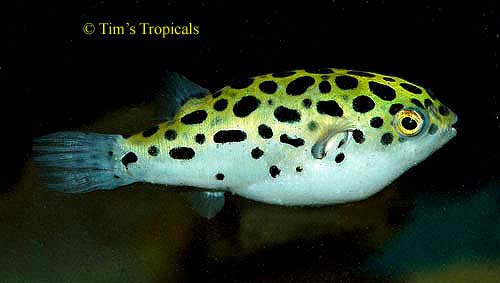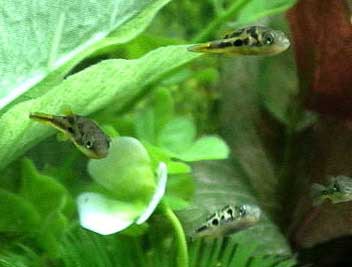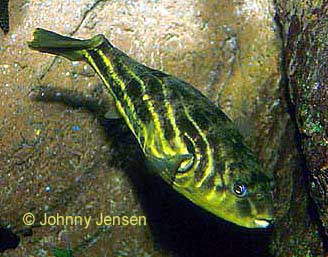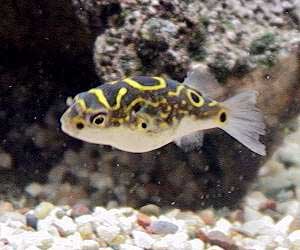Puffers
Puffers are a specialty tropical fish. Their small size makes it difficult to find suitable tank mates, other than puffers. Puffers are unusual because they can tolerate slightly salty aquarium water, but they can't survive in a saltwater aquarium.
Spotted Green Puffer

Spotted Green Puffer
Spotted Green Puffers are my personal favorite. I have had one now for two years and
he's getting big. I must say from what I have seen, they are one of the smartest fish and are friendly to humans. Spotted Green Puffers do get nippy and aggressive at times. They can be placed in a community tank with other fish, but keep a close watch and feed them well. These spotted green puffers are always hungry. I find if they are feed them three times a day in smaller amounts that they nip less. Their nipping also depends on the size of the tank and the amount of swimming space that they have.
Spotted Green Puffers - Aquarium Setup
Spotted Green Pufferfish are very entertaining to watch, especially
their swimming patterns. They will live a long time if taken care of properly.
From my experience, this type of puffer is very sensitive, so if you are a
beginner, I suggest you start with the hardier dwarf puffer. Spotted Green
Pufferfish eat frozen then thawed bloodworms, ghost shrimp and pond snails . The snails keep their
beak from growing too large. These puffers are a definite brackish water
fish. When they get older, they can be introduced slowly into a fully saltwater
environment. In saltwater, they will do better and their colors are
vibrant.
Spotted Green Puffers - Profile
-
Scientific Name: Tetraodon nigroviridis
-
Family: Puffer
-
Temperature: 24 - 28 C; 75 - 82 F
-
pH: 8
-
Size: 10 - 17 cm; 4 - 7 inches
-
Life Span: years
-
Breeding: Difficult
Spotted Green Puffers - Compatibility:
Spotted Green Puffers are compatible with other puffers. They are nippy in a community tank unless they have adequate space and food.
Dwarf Pufers - by Jasandjules

Dwarf Puffer or Pea Puffer
Many thanks to Jasandjules for the the following article: - Dwarf puffers - The little fish with BIG character
Dwarf puffers (dps) are a relatively new discovery, a few years ago when India started exporting more of their native fish to the States and Europe there were a few relatively obscure puffers about the size of a pea ( hence one of their trade names, the pea puffer). They were originally assumed to be juvenile examples of already known puffers but it soon became clear this was not the case.
Dwarf Puffers - Unusual Characteristics
Dwarf Puffers or "Dps" have some unusual characteristics. Adult dwarf puffers reach a size of about 1 inch. They have black eyes that turn blue when they are in the light and their eyes can move independentl, like Chameleons. Dwarf Puffers can open or close their tail fin depending if they're stopping or going. They will also 'curl' their tail which can indicate stress or illness but also just a way of maneuverability. They also can be seen opening their mouths up wide, as if yawning. Their spots/patches are different colours and shades, from bluish green to black and from light to dark. Dwarf puffers can also change how dark or faded their spots are, depending on their mood.
Dwarf Puffers - Sexual Differences
Determining the sex of dwarf puffers when they are young is very difficult but easy in adults. The males have a dark line running down their belly ( as well as more yellow colouring on their bellies). The vertical line on the males darkens with sexual maturity and during spawning. The males also have lines or wrinkles behind/above their eyes that the females do not have. The females body is also much rounder than the males.
Dwarf Puffers - Aquarium Setup
Dwarf puffers are best when kept in a 20 gallon, 1 male and 2 females. The tank should be very heavily planted so the dwarf puffers line of sight is constantly broken and they have hiding places. This will greatly reduce the amount/ chance of aggressive behaviour.Dwarf puffers do not need to
school, so a single dp can be kept. There are also examples of people keeping 20 in a 20g ( very
very heavily planted) with few problems, but I wouldn't recommend it, especially if you are new to
dwarf puffers. Ideally dwarf puffers need about 3 gallons each.
Dwarf puffers are quite hardy and will tolerate varying water conditions but obviously will do best, as with any fish, in optimum water conditions. They do best at temperatures of 80/26 degrees with a ph of at least 7.
Dwarf Puffers - Tank Mates
As far as tank mates go, although there are a number of examples of people keeping
dwarf puffers in a community tank, it is not recommended! Otocinclus or ottos make excellent tank mates and very few people have had any problems at all with these coexisting. Amano or ghost shrimp are another possibilty, but if the dwarf puffers discover how tasty they are then the peaceful coexistence comes to an end!! It is probably a good idea, as with any non species tank, when dealing with varying levels of aggression, to add the least
aggressive first (obviously the oto in this case) to allow them to 'claim' territories first.
Dwarf Puffers - Feeding
Dwarf puffers will eat frozen foods (bloodworms being the most common and popular amongst dp owners), live foods (blackworms, brine shrimp, snails etc). They will not eat flake food or freeze dried as a rule. If they won't eat any flake food then don't consider it as a staple! Although dwarf puffers don't have the need for snails to blunt their teeth the way other puffers do ( most puffers have teeth that continue to grow and grow, like rabbits!), snails can still form a large part of their diet. Dwarf Puffers will enjoy hunting snails in their tank. They are
just more likely to suck the snails out of the shell as opposed to crunching down!
Dwarf Puffers - Freshwater or Salty Water?
PLEASE NOTE
Dwarf puffers are 100% fresh water fish, they do not require any salt, unlike some other freshwater puffers they do not require salt as they grow older, although they will tolerate small increases in salinity they are at optimum health in pure fresh water. Dwarf puffers are a very intelligent, interesting fish, they are very aware of 'outside' the tank, and will spend as much time watching you as you do watching them. Give them a try!!
Dwarf Puffers - by Lexcy
Many
thanks to Lexcy in Abbotsford, BC for all the following information:
These tiny puffers are imported from India. They are surprisingly hardy
fish and they are also know as pea puffers. They are said to be semi aggressive, but I find they are a good community fish, as long as you have a big enough tank. Males have a brown vertical line on their belly, which can darken and fade. The females don't have this. Dwarf puffers seem to eat bloodworms. If they don't at first, then try little tiny pond snails and ghost shrimp. They stay tiny at about 3 cm and don't eat your plants. They don't require any salt, but I do add a little. These little guys do have a personality. They eat right out of my fingers, if I hold the food semi in the water. They see me when I'm near the tank and all swim up to see what I'm doing.
They are very cute fish.
Dwarf Puffer - Profile
-
Scientific Name: Carinotetraodon travancoricus
-
Family: Puffer
-
Temperature: 22 - 28 C; 72 - 82 F
-
pH: 7.0 - 8.3
-
Size: 2.5 cm; 1 inch
-
Life Span: years
-
Breeding: Difficult, Egg Layer
Dwarf Puffers - Compatibility:
Dwarf puffers or pea puffers are compatible with other puffers. They also do well in a large community tank.
Fahaka Pufer

Fahaka Puffer
Figure 8 Pufer

Figure 8 Puffer
|



